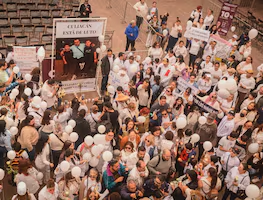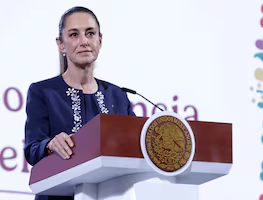Más Información

Mexicanos Primero lamenta la muerte de los niños Alexander y Gael; exige atender con firmeza la violencia en Sinaloa

Corte atrae amparos que frenan la operación del CEPJF para la elección judicial; se someterá a discusión en el pleno

SRE revisa frontera con Guatemala para garantizar bienestar y seguridad; subsecretaria recorre Estación Migratoria Siglo XXI

Sheinbaum prepara reforma para desaparecer a pluris; cuestiona a Noroña si defiende “la lista o la representación de las minorías”

Sheinbaum expresa su solidaridad con familia de niños asesinados en Sinaloa; instruye a Segob a atender el caso
A Google search about the term “ COVID-19 ” throws over 5 billion results in 0.57 seconds. In each one of the 86,400 seconds that make up a day, there is new information that is read, translated, understood, explained, and shared in different ways all over the world. According to information of the International Telecommunications Union (ITU) , over 50% of the world population has access to the internet, that is, at least 3.9 billion people in the world surf through a sea of information that, in times of a pandemic, is all about the new coronavirus.
Rivers of information flow at a high speed through social networks . In group messages, there are myths and popular beliefs mixed with fake news that, after being repeatedly shared, have become irrefutable truths. There are also news from reliable sources and others from which a couple of paragraphs have been extracted, turning into half-truths that give the originals a new interpretation every time they are shared. The daily challenge turns into a game of discovering the truth and the lie after receiving a new message.
Recommended: COVID-19: The symptoms of the new coronavirus
As people are forced to practice physical distancing to prevent the spread of the new coronavirus , social networks have become an excellent option to keep in touch with friends, family, and colleagues; unfortunately, they have also become a source of unreliable information and bad advice , some of which are even dangerous, that can disseminate at a higher speed tan SARS-CoV-2 itself. The pandemic also affects information .

The appeal of deceit
Exchanging information on social networks is a good thermometer to see the evolution of fears regarding the virus. Jeff Hancock , a professor of communication at the Humanities and Sciences Faculty at Stanford and director-founder of the Social Media Laboratory in that university, recently published a text where he explains why fake news are so appealing.
Compared to real news , fake news usually includes surprising information. Another of the characteristics listed by Hancock is that the most viral news usually causes clear feelings of rage or anxiety . Any information that falls into this category must be verified.
Other red flags include unknown sources , easy remedies , rumors from friends or close relatives, an unusual number of reactions in social networks, and photoshopped pictures or memes . In this sense, Hancock explains that platforms are also assuming their part of responsibility by eliminating content that is clearly fake to avoid the spread of false information . On the other hand, people should learn to really read the information they share (not only the heading and the summary), making sure to verify their sources and searching for news from reliable agencies .
Recommended: COVID-19 FAQs
During the pandemic , it has been common to find “ miracle cures ” in social networks, including a hot garlic tea, drinking water constantly, or baking soda rinses, that, although they are useless against COVID-19, they are not harmful to those who try them. However, there are other things that could cause problems, such as fake news about the use of silver dag to fight the virus that could actually cause kidney damage .
The use of silver dag to treat infections became a trend in Europe and the U.S. but since 1997 , the FDA has warned people about the lack of security involved in its use that could also explain argyria , a condition that turns the skin gray after a long time of its consumption.
Since February, the World Health Organization released the first warnings about the possible consequences of the information pandemic , the reason why institutions like the International Network of Data Verification , with affiliated agencies in 45 countries, such as AFP , published, since the beginning of the epidemic, nearly 150 articles verifying the most viral false affirmations. One of the most concerning: The recommendation to drink bleach to cure COVID-19- Bleach is a corrosive liquid that is used to disinfect and its consumption is mortal. Its consumption would seem absurd, but people can make bad decisions out of fear.
The expert explains that when people are afraid , they look for all kinds of information to reduce uncertainty , so it is easy for them to find incorrect or deceiving information simply because it helps them feel better and blame others for what is happening. This helps explain why conspiracy theories have become so strong. After the appearance of the new virus and the arrival of the epidemic, just as happened with ebola and zika , there is the idea that the virus was created in a laboratory to eliminate a certain sector of the population or with the objective to make pharmaceutics wealthier.
Although disbelief might reign some times, there is no evidence that suggests the virus is artificial. Experts have been in charge of demonstrating it tirelessly: SARS-CoV-2 is very similar to other two coronaviruses that have unleashed outbreaks in the last decades: SARS-CoV and MERS-CoV . The three viruses originated in bats as natural coronaviruses that then jumped from animals to people. The conspiracy theory is more exciting but less authentic .

Half-truths
The ease with which we can have access to information can become dangerous . On one hand, it has been essential for the democratization of science and for the research done in a laboratory can be known almost instantly and on detail by researchers from all over the world to join efforts in a timely manner. Nevertheless, this has also caused that, without the necessary tools to understand scientific research and by fragmenting or decontextualizing it, the essential points of the research can be disrupted .
Recently, a piece of news on social networks claimed that the cure for coronavirus had been found in China through an injectable medication . Unfortunately, this is completely false, but the information could have been generated from the use of tocilizumab , an injectable synthetic protein that is used in patients with rheumatoid arthritis and that a group of Chinese doctors began to try in patients with serious COVID-19 cases as part of a combined treatment to block the effects of the IL-6, a protein in the body that is produced when there is swelling. Until now, there is not a specific viral treatment designed for COVID-19; the symptoms are treated with medications depending on the seriousness of the case.
Recommended: COVID-19: Myths vs Facts
There was another news about the dangers of a common use medication, ibuprofen . The viral news said the use of this medication could exacerbate the effects of the virus. The article that originated this affirmation was published on March 11 by The Lancet Respiratory Medicine under the title “Are patients with hypertension and diabetes mellitus at increased risk for COVID-19 infection?” This article actually poses the hypothesis that the treatment for diabetes and hypertension with stimulating medications of the ACE2 can increase the risks of developing COVID-19 more seriously but without clinical trials of a certain medication and making reference to the Asian genetic characteristics. Either way, ibuprofen was so demonized that the WHO had to issue a statement on March 19 saying there is no clinical information on the topic, nor reports on negative effects beyond the secondary effects already known.

A similar story happened with the news about two persons with O blood type . The information was extracted from an article published by medRvix, an online archive for preliminary reports on health science. The investigation was based on research at three hospitals in two Chinese provinces that do not constitute a representative sample and that actually made reference to the O blood type showing a less risk of infection in comparison to the A blood type
In the case of the information pandemic , physical distancing could also imply turning away from the constant bombardment of information , mostly of the one that is spread through rumors . Looking for veracity before spreading the fake news virus is the best way to lighten the terror of the pandemic is to look for veracity before spreading the virus of the pandemic.
Recommended: COVID-19: How to take care of your mental health during the coronavirus outbreak
mp
Noticias según tus intereses

El monumento que Trump tiene que inaugurar en México | El Universal

El tramposo comportamiento de Noroña | El Universal

CJNG, Cártel de Sinaloa, La Familia, Cárteles Unidos y el Cártel del Noreste, esta es su historia; entrarán a la lista de terroristas de EU | El Universal

Localizan en Puebla a menor desaparecida en Baja California; detienen a hombre que viajaba con la víctima

Se analiza demanda civil contra Google por renombrar a todo el Golfo de México: Sheinbaum; “no es una norma internacional”






